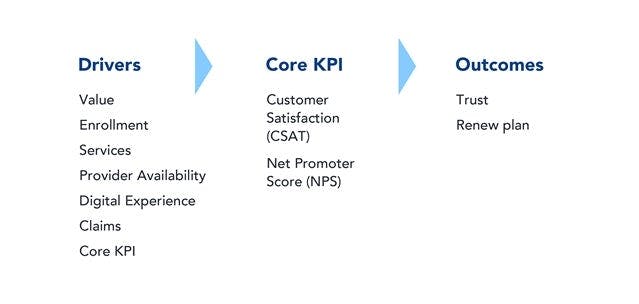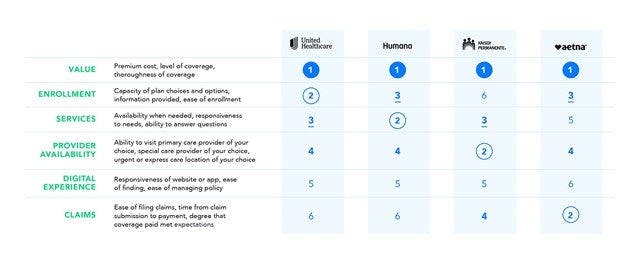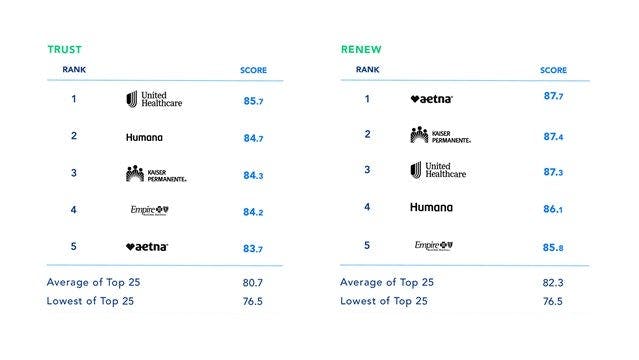How Health Insurers Can Use Predictive CX to Drive Trust, Recommendations, and Renewals


Managing and optimizing the customer experience is an increasingly complex task for health insurers.
Yet, according to research from Forrester, Gartner, and Verint, the best way to engage customers, improve service across channels, and reduce costs is to improve customer experience throughout the entire health insurance journey. That means that even though it’s challenging, it’s worth doing and will pay dividends.
The Verint Experience Index (VXI): Health Insurance Edition surveyed more than 6,000 members about their health insurance plans to understand which companies are providing the best experience. Part of our research allows us to see what drives trust, recommendations, and renewals.
Following is a little bit more about how our methodology works and what it tells us about health insurance customer experience.
The 3 Essential Questions for Health Insurance Managers
Understanding and managing customer experiences across multiple channels and touchpoints requires measurement systems that address three essential management questions:
- How are we doing? The system must measure all areas of the customer’s experience with the health insurer and provide accurate and precise diagnostic measurement of performance in each area.
- What should we do? The system should provide managers the capability to prescribe two things:
- what performance improvement targets are needed to enhance health insurance customer experiences
- how they should be prioritized
- Why should we do it? Managers need a system with the predictive power for assessing how resources allocated to improvement targets will affect future business outcomes and ROIs before they make the investment.
Verint’s Methodology
The methods behind the Verint Experience Management methodology models and technology have a proven relationship with customer spending, shareholder value, cash flows, and business performance. The underlying theory and modeling approach supporting the index are based in the fields of consumer psychology and psychometrics, coupled with advanced analytic techniques from statistics and econometrics.
In short, the way that Verint measures the health insurance customer experience is more than just a survey-based beauty contest. We use a deeply scientific, rigorous model to understand what drives customer experience, and what the potential positive outcomes of a good customer experience are.
Our model has three components that address those three management questions above. Our model can be customized for any individual client or industry. Here’s an overview of the model we used in the VXI: Health Insurance report:

Question 1: How are we doing?
Health insurance executives can use the center of the model (above) to determine how they are doing. When Verint measures CSAT, the score for each respondent is the average of the three responses using optimal weighting, rescaled from a 1-10 response scale to a 0-100 score scale. The individual health insurer is then given a score on a 100-point scale that reflects those individual consumer responses.
To see CSAT scores for each of the top 25 health insurance companies in the U.S., download the full report.
Question 2: What Should We Do?
This second question is where Verint’s methodology really starts to shine. Verint’s methodology measures several key drivers of satisfaction and is able to calculate the relative impact of those elements on CSAT. By doing so, leaders are able to determine which elements of the experiences should be prioritized.
The drivers we measured for the VXI: Health Insurance report were:
- Value: Premium cost, level of coverage, thoroughness of coverage
- Enrollment: Capacity of plan choices and options, information provided, ease of enrollment
- Services: Availability when needed, responsiveness to needs, ability to answer questions
- Provider Availability: Ability to visit the primary care provider of your choice, special care provider of your choice, urgent or express care location of your choice
- Digital Experience: Responsiveness of website or app, ease of finding, ease of managing policy
- Claims: Ease of filing claims, time from claim submission to payment, degree that coverage paid met expectations
Value ranks as the most important driver of satisfaction for most but not all of the top 25 U.S. health insurers. However, some measured companies had other priorities for improvement.
Additionally, scores tend to be lower for the “digital experience” driver. As more members turn to digital tools, this area could represent an area of untapped potential.

Insurers not in the top 25 can learn a lot by looking at the top 25. However, it’s still essential for each company to measure and manage its own users because there are so many differences from company to company.
Question 3: Why Should We Do It?
Verint’s methodology proves that satisfied members are more likely to trust their health insurer and renew policies. It’s worth noting the insurance companies that rank at the top for member satisfaction also place highest in terms of outcomes. Here’s how the top five rank.

Individual companies in the top 25 can contact Verint for a customized briefing on their performance.
The Takeaway: A Model that Drives Better Business Decisions
When it comes to delivering positive experiences, cause-and-effect insight can be the most powerful tool at your disposal. But without knowing which actions will yield real benefits, business decision-making can quickly become a guessing game.
Relying on simple correlations, incomplete data, or—worse yet, faulty assumptions based on previous experience—can waste valuable time and resources.
When health insurance customer experience is measured using a proven, data-driven model, it provides insights that drive better, more informed decisions that can impact revenue, loyalty, retention, and competitive advantage.